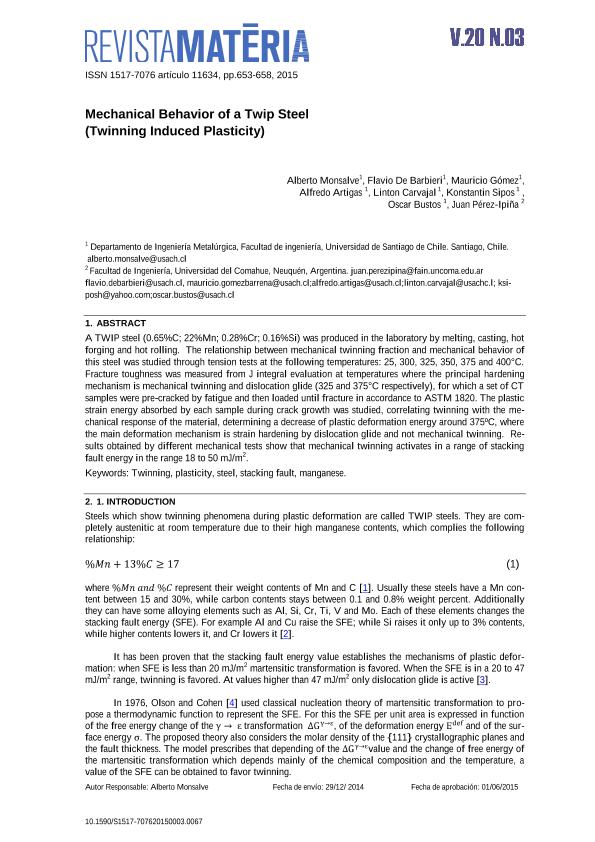Mostrar el registro sencillo del ítem
dc.contributor.author
Monsalve Alberto
dc.contributor.author
Barbieri, Flavio
dc.contributor.author
Gómez, Mauricio
dc.contributor.author
Artigas,Alfredo
dc.contributor.author
Carvajal, Linton
dc.contributor.author
Sipos, Konstantin
dc.contributor.author
Bustos, Oscar
dc.contributor.author
Perez Ipiña, Juan Elias

dc.date.available
2016-12-16T20:13:29Z
dc.date.issued
2015-07
dc.identifier.citation
Monsalve Alberto; Barbieri, Flavio; Gómez, Mauricio; Artigas,Alfredo; Carvajal, Linton; et al.; Mechanical Behavior of a Twip Steel (Twinning Induced Plasticity); Univ Fed Rio de Janeiro; Revista Matéria; 20; 3; 7-2015; 653-658
dc.identifier.uri
http://hdl.handle.net/11336/9620
dc.description.abstract
A TWIP steel (0.65%C; 22%Mn; 0.28%Cr; 0.16%Si) was produced in the laboratory by melting, casting, hot forging and hot rolling. The relationship between mechanical twinning fraction and mechanical behavior of this steel was studied through tension tests at the following temperatures: 25, 300, 325, 350, 375 and 400°C. Fracture toughness was measured from J integral evaluation at temperatures where the principal hardening mechanism is mechanical twinning and dislocation glide (325 and 375°C respectively), for which a set of CT samples were pre-cracked by fatigue and then loaded until fracture in accordance to ASTM 1820. The plastic strain energy absorbed by each sample during crack growth was studied, correlating twinning with the mechanical response of the material, determining a decrease of plastic deformation energy around 375ºC, where the main deformation mechanism is strain hardening by dislocation glide and not mechanical twinning. Results obtained by different mechanical tests show that mechanical twinning activates in a range of stacking fault energy in the range 18 to 50 mJ/m2.
dc.format
application/pdf
dc.language.iso
eng
dc.publisher
Univ Fed Rio de Janeiro

dc.rights
info:eu-repo/semantics/openAccess
dc.rights.uri
https://creativecommons.org/licenses/by-nc-sa/2.5/ar/
dc.subject
Twinning
dc.subject
Plasticity
dc.subject
Steel
dc.subject
Stacking Fault
dc.subject
Manganese
dc.subject.classification
Otras Ingeniería de los Materiales

dc.subject.classification
Ingeniería de los Materiales

dc.subject.classification
INGENIERÍAS Y TECNOLOGÍAS

dc.title
Mechanical Behavior of a Twip Steel (Twinning Induced Plasticity)
dc.type
info:eu-repo/semantics/article
dc.type
info:ar-repo/semantics/artículo
dc.type
info:eu-repo/semantics/publishedVersion
dc.date.updated
2016-12-12T14:38:16Z
dc.identifier.eissn
1517-7076
dc.journal.volume
20
dc.journal.number
3
dc.journal.pagination
653-658
dc.journal.pais
Brasil

dc.journal.ciudad
Río de Janeiro
dc.description.fil
Fil: Monsalve Alberto. Universidad de Santiago de Chile; Chile
dc.description.fil
Fil: Barbieri, Flavio. Universidad de Santiago de Chile; Chile
dc.description.fil
Fil: Gómez, Mauricio. Universidad de Santiago de Chile; Chile
dc.description.fil
Fil: Artigas,Alfredo. Universidad de Santiago de Chile; Chile
dc.description.fil
Fil: Carvajal, Linton. Universidad de Santiago de Chile; Chile
dc.description.fil
Fil: Sipos, Konstantin. Universidad de Santiago de Chile; Chile
dc.description.fil
Fil: Bustos, Oscar. Universidad de Santiago de Chile; Chile
dc.description.fil
Fil: Perez Ipiña, Juan Elias. Consejo Nacional de Investigaciones Científicas y Técnicas; Argentina. Universidad Nacional del Comahue; Argentina
dc.journal.title
Revista Matéria
dc.relation.alternativeid
info:eu-repo/semantics/altIdentifier/url/http://www.scielo.br/scielo.php?script=sci_arttext&pid=S1517-70762015000300653&lng=pt&nrm=iso&tlng=en
dc.relation.alternativeid
info:eu-repo/semantics/altIdentifier/url/http://dx.doi.org/10.1590/S1517-707620150003.0067
Archivos asociados
